Introduction
The blueberry grows both in the wild and as a commercial crop. It has doubled its commercial production from the year 2010 to 2019 from 439,000 t to 1.0 million t, of which the main producing countries are the United States, Canada, Chile, and Peru (USDA, 2021). The production of blueberries in Colombia ranks sixth among South American countries, with 304 ha cultivated in 2018, located mainly in the departments of Cundinamarca and Boyacá and harvested to satisfy local consumption (Agronet, 2022). Blueberries are fruits with a low sugar content, a high antioxidant capacity and a high content of flavonoids, among which anthocyanins stand out. Their consumption provides many benefits for human health (Salgado et al., 2018), among which the improvement of vision and antidiabetic properties are highlighted (Yang et al., 2022).
Currently, there are many varieties of blueberry on the market, including the 'Biloxi' variety that could easily adapt to different altitudes (Araujo et al., 2015). The fruits of blueberry crops could suffer from physical damage and attacks by pathogens and diseases during storage, resulting in economic losses. Different natural extracts and compounds, such as acibenzolar-S-methyl (ASM), have been tested, with positive effects on the conservation of fruits of mango (Mangifera indica L.) and cabbage (Brassica oleracea L.) (Ishiga et al., 2021); thus, increasing the postharvest life of blueberry fruits is possible.
ASM is a synthetic compound and chemical activator of plant resistance to diseases through the activation of specific genes (Colombo et al., 2018). It acts as a functional analog of salicylic acid, inducing systemic acquired resistance (SAR) (Jepersen et al., 2017). ASM maintains fruit quality by regulating enzymes that degrade the cell wall during storage in apples (Malus domestica Borkh) (Li et al., 2020).
The effect of different essential oils, including the extract of red thyme and oregano, proved to be very effective against mold in storage, and extracts of thyme, mint, and limonene had the most effective preservative action on stored strawberries during 14 d of postharvest (Saxena et al., 2020).
Applications of these products have been effective in the management of phytopathogens; however, the effect they have on the physical, chemical, and quality characteristics of blueberry fruits must be tested (Saxena et al., 2020). Therefore, the application of ASM and vegetable extracts (mint and coriander) was evaluated on the organoleptic characteristics and respiration rate of blueberry fruits stored at room temperature (16°C) during postharvest.
Materials and methods
Location
This research was developed in the Plant Physiology Laboratory of the Universidad Pedagógica y Tecnológica de Colombia (Boyacá, Colombia), Tunja, at 5°33'16" N and 73°21'09" W, with an average annual temperature of 16°C and average relative humidity of 65%.
Materials
The fruits were harvested from an organic commercial crop two years of age, located on the 'La Nutria' farm, El Carmen village in the municipality of Combita, at an altitude of 2697 m a.s.l., 5°41'54'' N and 73°16'11'' W, with an average annual temperature of 12.5°C and relative humidity ranging from 70% to 80%.
Twenty kg of 'Biloxi' variety blueberry fruits was collected with average weights of 1.3 to 1.5 g per fresh fruit, between 6:00 and 8:00 a.m. These were transported in 10 kg plastic baskets from the farm to the laboratory, under ambient conditions in a time of 35 min. Ripe fruits were selected according to the Colombian technical standard for blueberries NTC-6373 (Icontec, 2019), free from mechanical damage and with a uniform dark purple color and a size greater than 8 mm in diameter, using a grading sieve in order to homogenize the sample.
To obtain coriander (Coriandrum sativum L.) and mint (Mentha piperita L.) extracts, 69.92 g of seed and 385.8 g of mint leaves were used, washed, dried at a temperature of 30°C at 35°C, respectively, macerated and immersed in 240 ml and 500 ml of 35% (v/v) ethyl alcohol, respectively. The extracts were stored at 4°C in glass jars in the refrigerator and in the dark for 15 d, then filtered for later application (Morais et al., 2015).
Experimental design
Extracts were applied to the blueberry fruits with a completely randomized design with five treatments as follows: T1) coriander extract (Coriandrum sativum L.), T2) mint extract (Menthapiperita L.), T3) 50 mg L-1 of acibenzolar-S-methyl (ASM), T4) 100 mg L-1 of ASM, and T5) fruits immersed in distilled water. Each treatment had four replicates, for a total of 20 experimental units (EU). Each EU had about 500 g of blueberry fruits, stored at 16°C in commercial plastic boxes KIT 250-H53 (Proplantas S.A.®, Colombia), after being subjected to immersion in the different treatments for 5 min.
Physicochemical properties
The following variables were evaluated daily: 1) fruit firmness using a GY-4 penetrometer (Yueqing Handpi Instruments Co., Ltd, China) with a 3.5 mm tip, a pressure depth of 10 mm, a 0.01 N precision, and 3 fruits with uniform size for each EU; 2) contents of total soluble solids (TSS) using a Hanna HI 96803 refractometer with a scale from 0% to 85% (Hanna Instruments, Woonsocket, RI, USA), and measuring the Brix degrees in juice extracted from 12 fruits; 3) total titratable acidity (TTA) quantified with the methodology used by Álvarez-Herrera et al. (2015) through calculations with data on the volume of sodium hydroxide (NaOH) incorporated in 5 ml of fruit juice brought to 50 ml with distilled water, adding three drops of phenolphthalein as an indicator of color change and using equation (1).
Where: A = volume of NaOH (ml); B = normality of NaOH (0.097); C = equivalent weight expressed in g of predominant acid in the fruit (citric acid 0.064 g meq-1); D = mass in grams of the sample used (5 g).
a*: chromaticity from green to red, b*: chromaticity from blue to yellow, and L*: luminosity were determined. The hue angle and chroma were calculated according to the equations (2) and (3).
The respiratory rate (RR) was determined with a 2 L SEE BC-2000 (Vernier Software & Technology, OR, USA) hermetic breathing chamber connected to a VER CO2-BTA infrared sensor (Vernier Software & Technology, OR, USA) and Labquest2 interface (Vernier Software & Technology, OR, USA) for 10 min, expressed in mg of CO2 kg-1 h-1. The total anthocyanins (TA) in fruits were quantified with a 0.25 g blueberry fruit sample, homogenized in 1 ml of 0.1% citric acid solution, and 10 ml of 80% ethanol; 4 ml of the sample were centrifuged in a Unico C858 Model PowerSpin LX (Unico Scientific, Hong Kong) at 4000 rpm for 20 min. Absorbances were measured at 532 nm with a HumanCorp UV/Visible X-ma 1200V spectrophotometer (Human Corporation, Seoul, Korea). The TA content (mg 100 g-1 of fresh fruit weight (FW)) was calculated and reported as cyanidin-3-glucoside equivalents (Cy-3-glucoside) using equation (4) (Zapata et al., 2014).
Where abs is absorbance measured in the spectrophotometer, MM is molecular mass of cyanidin-3-glucoside, 449.2 g mol-1, DF is the dilution factor (10), e is the molar extinction coefficient for cyanidin-3-glucoside (26900), and 1000 is the conversion factor from g to mg.
Statistical analysis
The data were subjected to normality tests to eliminate erroneous and atypical values. Once the assumptions of normality had been verified, a transversal and longitudinal analysis of variance (ANOVA) was carried out to determine significant differences between the treatments and measurement times. The average of the variables was subjected to the Tukey's means comparison tests (P<0.05); the analyses were performed with SAS v.9.2e (SAS Institute Inc., Cary, NC).
Results and discussion
Accumulated mass loss in fruits
There were significant differences for accumulated mass loss (ML) during the first three measurements at 1, 2, and 3 d after harvest (dah). Afterwards, it homogenized and was constant for all treatments during the postharvest phase of the blueberry fruits. The absence of significant differences between treatments agrees with Li et al. (2020) who found that apple fruits treated with ASM did not have ML that was significantly affected with respect to the control treatment.
At 13 dah, the treatment without applications had the highest ML, while the lowest ML values were seen in the fruits with applications of the mint extract. The ML of the blueberry fruits at 15 dah was 19.6% on average, higher than reported at 15 dah by Jaramillo-Sánchez et al. (2019) of1.8% and 3% for the control and ozone treatment, respectively, and higher than reported by Paniagua et al. (2013) in the third postharvest week for chilled blueberries, which ranged between 1% and 15%.
At 4 dah, there were no significant differences in ML because ML in fleshy fruits is due to water loss, which is directly proportional to the vapor pressure deficit (VPD) between the fruit and the environment; therefore, at longer storage times there would be greater water losses that can be diminished by the initial protective effect of treatments. When a berry loses around 6% water, it loses commercial quality (Díaz-Pérez, 2019). So, the blueberry fruits reached 13 d with an acceptable consumption quality, which is longer than the commercial grade (4 dah).
Fruit firmness
Firmness only had significant differences at 6 and 13 dah (Fig. 1). The treatment with 50 mg L-1 of ASM reached the highest firmness at 13 dah. The firmness of the equatorial part of blueberry fruits increased throughout the posthar-vest phase with an average for all treatments of 5.06 N at harvest and 6.41 N at the end of the storage period. And the fruits that received applications of coriander extract at the beginning of the postharvest extract stood out, and achieved an increase in firmness of 50% (Fig. 1), from 4.5 N to 6.8 N. This was probably due to an increase in the extensibility of the fruit epidermis, that means that, even though the fruits were softer to the touch due to the action of enzymes such as polygalacturonase (Yahia et al., 2019), they had greater resistance to breakage by the penetrometer.
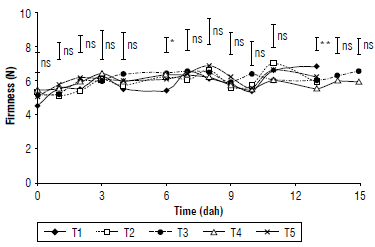
FIGURE 1 Firmness of blueberry fruits subjected to different preservative treatments during 15 d after harvest (dah): T1) coriander extract; T2) peppermint extract; T3) acibenzolar-S-methyl 50 mg L-1; T4) acibenzolar-S-methyl 100 mg L-1; T5) fruits immersed in distilled water, ns) no significant, * and ** indicate significant effect according to the ANOVA (P<0.05 and P<0.01, respectively) between treatments. Vertical bars indicate the Tukey range test (P<0.05).
Jaramillo-Sánchez et al. (2019) find firmness values in blueberry fruits ranging between 2.2 and 2.6 N with maximum displacement of the epidermis before rupture of 4-5 mm. Cortés-Rojas et al. (2016) find that 'Biloxi' blueberries have firmness averages of 2.1 N, similar to the softening data of Xu and Liu (2017), 3 N to 1.5 N throughout storage. These authors find lower firmness values in blueberry fruits than those in the present study, probably, because the latter were harvested at commercial maturity and brought directly to the laboratory the same day to start the postharvest measurements.
Contents of total soluble solids
Although there were significant statistical differences in many of the measurements recorded over time, they did not occur at all sampling times (Tab. 1). However, the fruits that received applications of coriander or mint extracts at all times had higher average values of total soluble solids (TSS) (12.82 and 12.39 °Brix, respectively), while the treatments with applications of 50 and 100 mg L-1 of ASM and the control had lower average values (11.88, 11.95, and 11.94 °Brix). Similar results are reported by Saito et al. (2020) for the cultivars 'Draper' and 'Duke', which range between 11.4 and 13.2 °Brix, but higher results are obtained for the variety 'Biloxi' by Cortés-Rojas et al. (2016), whose averages oscillate around 13.6 °Brix.
TABLE 1 Contents of total soluble solids (TSS) and total titratable acidity (TTA) evaluated in blueberry fruits subjected to different preservative treatments 15 d after harvest (dah).
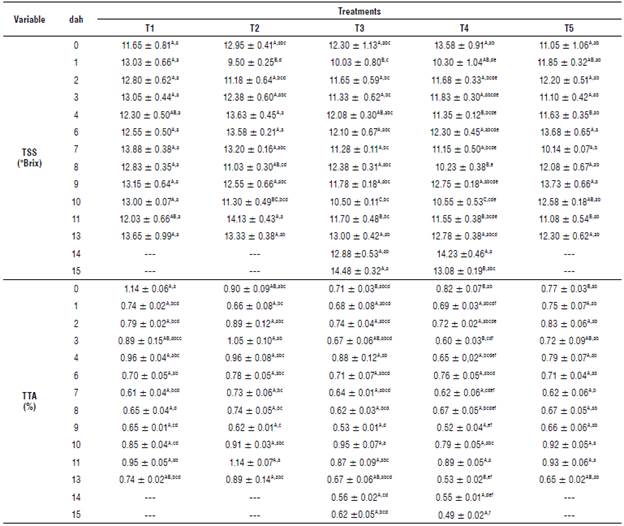
Means of 8 replicates ± standard error. Treatments correspond to blueberry fruits with applications of: T1) coriander extract; T2) peppermint extract; T3) acibenzolar-S-methyl 50 mg L-1; T4) acibenzolar-S-methyl 100 mg L-1; T5) fruits immersed in distilled water. Values followed by different uppercase letters in the same row indicate significant statistical differences between treatments (P<0.05). Values followed by different lowercase letters in the same column indicate significant statistical differences in postharvest time (P<0.05). (---) Loss of fruit quality of consumption.
All treatments significantly increased the TSS during postharvest storage, between 3% and 17%, except the fruits that received applications of 100 mg L-1 of ASM that had a reduction in TSS of around 4% (Tab. 1). Once the fruits were harvested, a greater breakdown of reserve carbohydrates to simpler sugars was generated. This degradation is normally faster in climacteric fruits after they reach physiological maturity that generates an increase in TSS. This results from an increase in the activity of enzymes such as a-amylase, ß-amylase, and starch Phosphorylase that hydrolyze starch (Yahia et al., 2019). The most abundant sugar in blueberry fruits is glucose, followed by fructose and galactose (Fotiric-Aksic et al., 2019). This TSS increase in blueberry fruits as they ripen and during storage is also reported by Gibson et al. (2013) but is contrary to that reported by Xu and Liu (2017), who obtain a decrease from 9 to 5 °Brix at 8 dah in fruits stored at 4°C. It is likely that the coating (quinoa protein-chitosan-sunflower oil edible film) has a positive effect on the accumulation of TSS during postharvest, as reported by Abugoch et al. (2015).
Total titratable acidity
There were significant differences between the treatments in total titratable acidity (TTA) only in the samplings carried out at 0, 3, 4, 9, and 13 dah (Tab. 1). The fruits subjected to applications of mint or coriander presented higher average TTA values (0.85% and 0.80%, respectively), while the fruits subjected to 50,100 mg L-1 of ASM, and the control had values of 0.70%, 0.66%, and 0.75%, respectively. This highlights the importance of applying coatings to fruits during postharvest since it is clear that coatings delay the loss of TTA and conserve the TTA longer (Gol et al, 2013).
The average TTA for all treatments tended to decrease significantly during the storage period, like that reported by Xu and Liu (2017). This decrease is attributed to the fact that many organic acids in fruits are used as a substrate in enzymatic reactions of respiration, such as occurs in berries and tomatoes, where the amount and concentration of malate and citrate decrease over time. Likewise, in strawberries and mangos, the amount of citrate and malate also decreases during storage (Vallarino & Osório, 2019). Once citrate has been produced in the tricarboxylic acid cycle (during the onset of maturation), it can be degraded to cytosol through the synthetic pathway of v-aminobutyric acid or converted to oxaloacetate and acetyl-CoA (Lee et al., 2021) as respiration intensifies and postharvest begins. This explains the decrease in TTA during fruit storage.
Contents of total anthocyanins
There were no significant differences between the treatments of total anthocyanin (TA) contents in fruits for any of the measurements over time (Fig. 2); however, the fruits that received applications of mint or coriander extract had higher TA values on average (83.9 and 74.1 mg 100 g-1 FW), similar to those found by Gibson et al. (2013) for Cy-3-glucoside (76 mg 100 g-1 FW of ripe blueberries, and within the range reported by Xu and Liu, 2017), 50 to 300 mg 100 g-1 FW of blueberries subjected to 1-methyl-cyclopropene doses and refrigerated at 4°C.
When analyzing the TA over time, a significant tendency to increase the TA during storage up to 13 dah (83.9 mg 100 g-1 of fruit FW) was observed. TA then decreased (66.54 mg 100 g-1 of fruit FW), similar to that reported by Gibson et al. (2013), who states that, once the fruits reached the optimum state of maturity, they were overripe, and the anthocyanin value began to decrease, especially Pet-3-glucoside, Pet-3-galactoside, Cy-3-glucoside, Cy-3-galactoside, Del-3-glucoside, and Del-3-galactoside, the main anthocyanins in blueberry fruits. Pet-3-glucoside is one of the most abundant anthocyanins in ripe blueberry fruits that changes from 0.4 mg 100 g-1 of dry mass in green fruits to 244 mg 100 g-1 of dry mass in ripe fruits (Gibson et al, 2013).
The increase in TA could be caused by an increase in the activity of enzymes, such as phenylalanine ammonium lyase (PAL) and chalcone synthase (СНА), whose product is chalcone, which degrades by chalcone isomerase to produce naringenin that then transforms into anthocyanin by a hydroxylation reaction and subsequent dehydration (Liu et al, 2018). This increase in the synthesis of anthocyanins maybe due to abiotic stress from the preservative applied to fruits, which affects the production of secondary metabolites (Chiabrando & Giacalone, 2017).
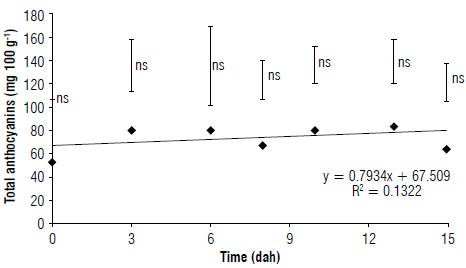
FIGURE 2 Total anthocyanin contents in blueberry fruits subjected to different preservative treatments during 15 d after harvest (dah). ns; no significant, * and ** indicate significant effect according to the ANOVA (P<0.05 and P<0.01) between treatments. Vertical bars indicate the Tukey range test (P<0.05).
Light/dark ratio
There were no significant differences between the treatments at any of the sampling points (Tab. 2); however, the control treatment reached, on average, the highest light/dark ratio (L*) value (33.2) throughout the postharvest phase, while the fruits that received applications of preservatives maintained lower L* values (31.5) because of the coating. These results agree with those of Chiabrando and Giacalone (2017), who report average values of L* 33.75 for all postharvest treatments applied at the beginning of storage and of L* 29.09 at the end of refrigerated postharvest (45 dah), higher than the average for the fruit treatment with chitosan of L* 17.51. It is likely that coatings with a preservative result in lower L* values because more layers are added to cover the fruit epidermis.
TABLE 2 Light/dark (L*), red/green (a*), and yellow/blue (b*) ratios evaluated in blueberry fruits subjected to different preservative treatments during 15 d after harvest (dah).
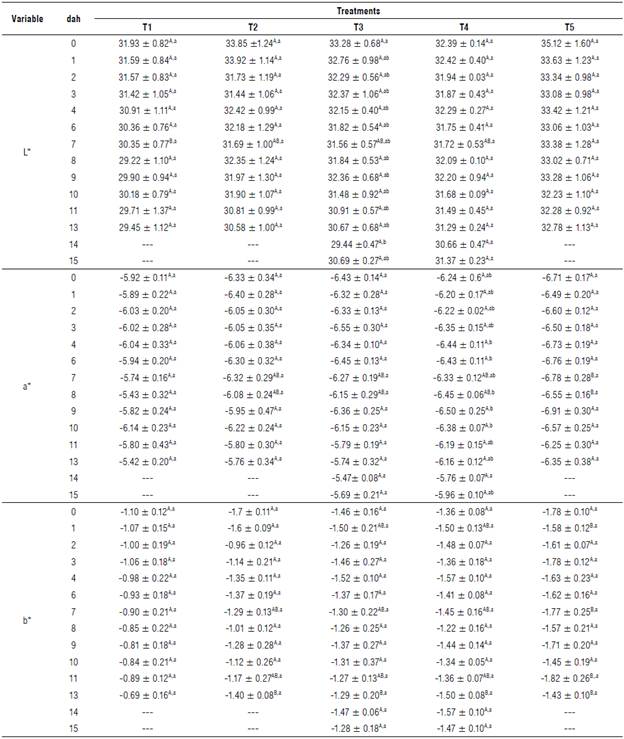
Means of 8 replicates ± standard error. Treatments correspond to blueberries with applications of the following: T1) coriander extract; T2) peppermint extract; T3) acibenzolar-S-methyl 50 mg L-1; T4) acibenzolar-S-methyl 100 mg L-1; T5) fruits immersed in distilled water. L*: luminosity; a*) chromaticity from green to red; b*) chromaticity from yellow to blue. Values followed by different uppercase letters in the same row indicate significant statistical differences between treatments (P<0.05). Values followed by different lowercase letters in the same column indicate significant statistical differences in postharvest time (P<0.05). (---) Loss of fruit quality of consumption.
The L* values decreased slightly during storage, from 33.3 to 31.0 on average; they did not show significant differences over time, except for the fruits that received applications of 50 mg L-1 of ASM that decreased from the beginning of postharvest (33.2) until the end of storage at 15 dah (30.68). These results are also reported by Chiabrando and Giacalone (2017) and are similar to those of Xu and Liu (2017), who, during 8 d of postharvest, find that L* values in blueberry fruits vary from 28.78 to 25.01. This indicates that, during the shelf-life, the fruits had a generalized loss of luminosity that accords with a darkening of the fruits because of oxidation, water loss, and internal browning attributed to inherent degradation in ripening and senescence (Cogo et al, 2011).
Red/green ratio
The ANOVA for red/green ratio (a*) did not show significant differences for the treatments in the measurements, except at 8 dah. The control treatment had the lowest a* values (-6.59), followed by the treatments with coatings of coriander or mint that showed higher average values (-5.84 and -6.11) (Tab. 2). Even though no significant differences were observed over time, an increase in the a* values were observed from -6.32 to -5.82, probably caused by the slight increase in darkening that occurs in blueberry fruits during storage. Xu and Liu (2017) make a similar report, where a* increased from the beginning of postharvest (-0.01) to the end of storage (0.29). Likewise, Zou and Hou (2017) obtain average values of 1.02 for a*, indicating that postharvest blueberry fruits lose green color and gain red color.
Yellow/blue ratio
For the yellow/blue ratio (b*), there were significant differences on the 1 d, 7 d, 11 d, and 13 d of measurement between the treatments (Tab. 2). The control treatment had the lowest b* values (-1.64), followed by the treatments with ASM applications that had values of -1.36 and -1.43 for 50 and 100 mg L4, while the blueberries treated with the coriander or mint extracts had higher values (-0.92 and -1.20, respectively). These results contradict those of Zou and Hou (2017), who report b* values of 1.87 that are positive; however, for the color space, similar tones are close to zero.
Chroma
The chromaticity of the blueberries showed significant differences between treatments at 0, 7, 8, and 14 dah, with an average value of 6.3 ± 0.23 (Tab. 3) that was higher than the values of 3.84 and 2.86 reported by EumefaL (2013) for the cultivars 'Bluetta' and 'Duke'. Likewise, Abugoch et al (2015) report that blueberry fruits have an average chroma of 4.8, lower than in this study. In addition, the chromaticity did not show significant differences over time and had a downward trend from 6.48 to 5.98 during postharvest.
Hue
The blueberries had significant differences at 0, 11, and 13 dah in terms of tonality (Tab. 3), with an average value for all treatments of 282 ± 1.1, within the range of 282 to 284 obtained by Abugoch et al. (2015) and less than the 290 and 302 obtained by Eum et al. (2013) for the cultivars 'Bluetta' and 'Duke'. The treatment with the highest tonality was the control (283.9), while the coated treatments had a lower tonality on average (281.3) because these fruits did not have applications on the epidermis that decreased the intensity of the color, according to Abugoch et al. (2015), who confirms that the coated fruits had lower tonality values.
TABLE 3 Chroma and hue evaluated in blueberries subjected to different preservative treatments during 15 d after harvest (dah).
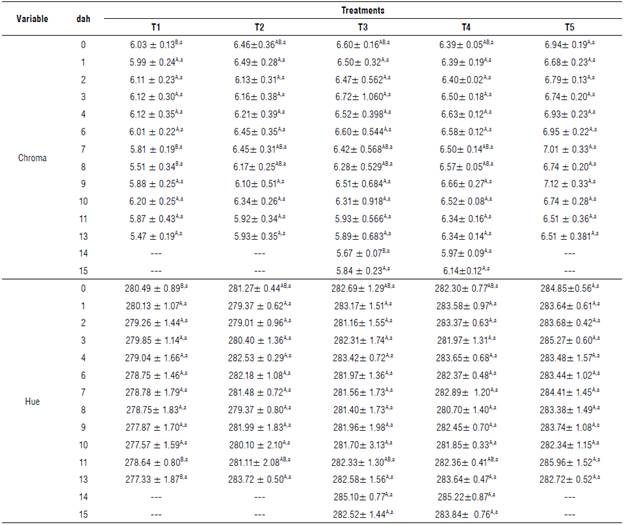
Means of 8 replicates ± standard error. Treatments correspond to blueberry fruits with applications of T1) coriander extract; T2) peppermint extract; T3) acibenzolar-S-methyl 50 mg L-1; T4) acibenzolar-S-methyl 100 mg L-1; T5) fruits immersed in distilled water. Values followed by different uppercase letters in the same row indicate significant statistical differences between treatments (P<0.05). Values followed by different lowercase letters in the same column indicate significant statistical differences in postharvest time (P<0.05). (---) Loss of quality of consumption.
Respiratory rate
There were only significant statistical differences in fruit respiration rate (RR) at d 1, 10, and 11 after harvest. Figure 3 shows that the ASM treatments slightly decreased the RR during most of the measurements throughout the postharvest, according to the report by Li et al. (2020) for apple fruits where the ASM applications inhibited RR. The blueberry fruits have non-climacteric behavior, similar to that established by Saltveit (2019). The average values at the beginning of storage were around 30.93 ± 2.65 mg of CO2 kg-1 h-1, within the range reported by Brackmann et al. (2010), but higher than that found by Xu and Liu (2017), who reported variations in the RR of 1.6 to 2.6 mg of C02 kg-1 h-1 for blueberries refrigerated at 4°C. RR values in blueberries are higher when fruits are not refrigerated.
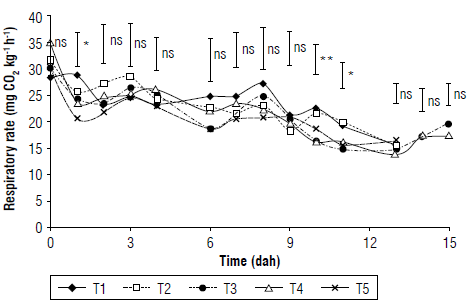
FIGURE 3 Respiratory rate in blueberry fruits subjected to different preservative treatments during 15 d after harvest (dah). T1) coriander extract; T2) peppermint extract; T3) acibenzolar-S-methyl 50 mg L-1; T4) acibenzolar-S-methyl 100 mg L-1; T5) fruits immersed in distilled water, ns: no significant, * and ** indicate significant effect according to the ANOVA (P<0.05 andP<0.01, respectively) between treatments. Vertical bars indicate the Tukey range test (P<0.05).
There were significant differences over time because the RR of the blueberries decreased throughout the postharvest period until reaching an average of 15.11 mg of C02 kg-1 h-1 at 13 dah, similar to the findings of Brackmann et al. (2010). This decrease of the RR in the blueberries was also obtained by Chiabrando and Giacalone (2017) and is attributed to a decrease in metabolism that is reflected in an increase in the concentration of TSS because they are used less in respiration (Guadarrama & Pena, 2013), as seen in the present study. In contrast, Xu and Liu (2017) find that the RR increased during storage, up to 8 dah in fruits refrigerated at 4°C that could have been due to the fact that refrigeration decreases the respiratory processes throughout the postharvest, while the fruits of this study had high RR at the beginning because they were stored at 16°C.
Conclusions
The application of mint extract decreased the loss of the accumulated mass in the blueberries. The firmness of the blueberries increased during storage, but the hardness did not. The fruits were softer and had wrinkling over time, that indicated that the epidermis of the fruits had high elasticity. The total anthocyanin values tended to increase during the first postharvest d and decreased once the fruits begin to lose their commercial quality. The fruits with applications of extracts of mint or coriander maintained higher values of total soluble solids and total titratable acidity. The red/green and yellow/blue ratio values increased. The blueberries had a slight loss of the blue hue during the postharvest, while the luminosity decreased. The respiration rate decreased throughout the storage period, while the total soluble solids increased. The application of acibenzolar-S-methyl extended the postharvest life of the blueberries, up to 15 dah (days after harvest), as compared to the other treatments (13 dah).

















